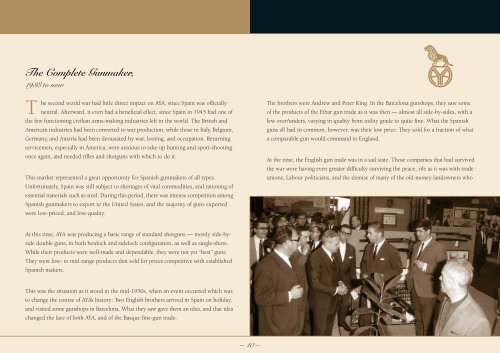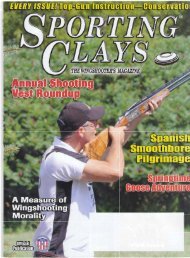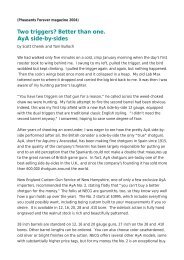. Cat.logo_AYA(1-15).fh8 - AYA, Aguirre y Aranzabal
. Cat.logo_AYA(1-15).fh8 - AYA, Aguirre y Aranzabal
. Cat.logo_AYA(1-15).fh8 - AYA, Aguirre y Aranzabal
You also want an ePaper? Increase the reach of your titles
YUMPU automatically turns print PDFs into web optimized ePapers that Google loves.
The Complete Gunmaker,<br />
1938 to now<br />
T<br />
he second world war had little direct impact on <strong>AYA</strong>, since Spain was officially<br />
neutral. Afterward, it even had a beneficial effect, since Spain in 1945 had one of<br />
the few functioning civilian arms-making industries left in the world. The British and<br />
American industries had been converted to war production, while those in Italy, Belgium,<br />
Germany, and Austria had been devastated by war, looting, and occupation. Returning<br />
servicemen, especially in America, were anxious to take up hunting and sport-shooting<br />
once again, and needed rifles and shotguns with which to do it.<br />
This market represented a great opportunity for Spanish gunmakers of all types.<br />
Unfortunately, Spain was still subject to shortages of vital commodities, and rationing of<br />
essential materials such as steel. During this period, there was intense competition among<br />
Spanish gunmakers to export to the United States, and the majority of guns exported<br />
were low-priced, and low-quality.<br />
At this time, <strong>AYA</strong> was producing a basic range of standard shotguns — mostly side-byside<br />
double guns, in both boxlock and sidelock configuration, as well as single-shots.<br />
While their products were well-made and dependable, they were not yet “best” guns.<br />
They were low- to mid-range products that sold for prices competitive with established<br />
Spanish makers.<br />
This was the situation as it stood in the mid-1950s, when an event occurred which was<br />
to change the course of <strong>AYA</strong>’s history: Two English brothers arrived in Spain on holiday,<br />
and visited some gunshops in Barcelona. What they saw gave them an idea, and that idea<br />
changed the face of both <strong>AYA</strong>, and of the Basque fine-gun trade.<br />
– 10 –<br />
The brothers were Andrew and Peter King. In the Barcelona gunshops, they saw some<br />
of the products of the Eibar gun trade as it was then — almost all side-by-sides, with a<br />
few over/unders, varying in quality from utility grade to quite fine. What the Spanish<br />
guns all had in common, however, was their low price: They sold for a fraction of what<br />
a comparable gun would command in England.<br />
At the time, the English gun trade was in a sad state. Those companies that had survived<br />
the war were having even greater difficulty surviving the peace, rife as it was with trade<br />
unions, Labour politicians, and the demise of many of the old-money landowners who




